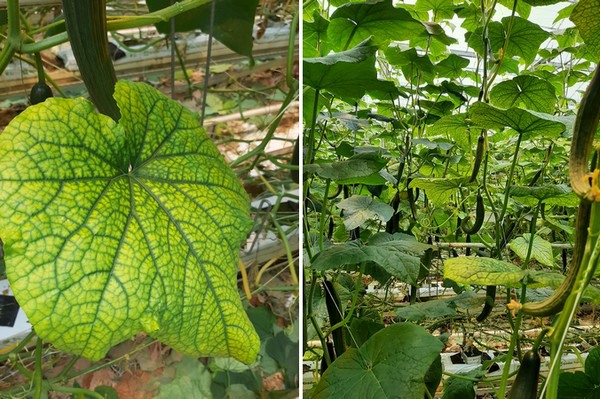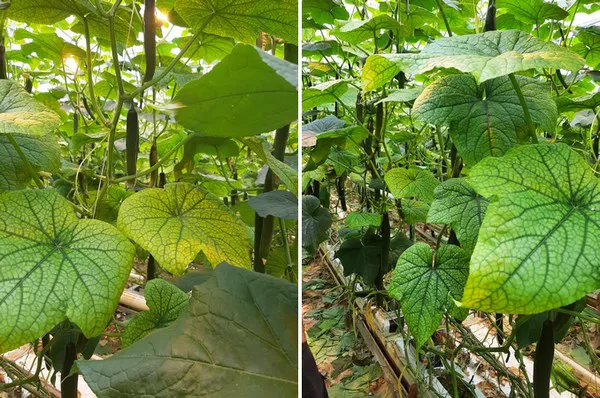In recent weeks, the Cucurbit Aphid-Borne Yellow virus (CABYV) has been found among more and more Dutch cucumber growers. This has been reported by Ewoud van der Ven and Rens Smith. The greenhouse vegetable advisors at Delphy are surprised by how quickly the originally Mediterranean plant virus has been spreading since June. The culprits are aphids. They are not easy to control with the current range of products.

Photos of CABYV, recently taken in a Dutch greenhouse
Symptoms
The symptoms of the virus are mainly the strikingly fast yellowing of leaves all over the plant. Growers from all over the Netherlands are already experiencing this. After a grower's test showed that it was CABYV, the ball started rolling. Ewoud speaks of a varying picture. "Sometimes only a few yellow plants are affected, but I have also seen growers where ten per cent of the plants are infected. Those plants lose a lot of production. According to reports from Germany, that can even lead to a fifty per cent loss in production."
According to the advisors, the virus picture resembles that of the Beet Pseudo-Yellow Virus (BPYV). Only, it seems that with CABYV, the yellowing of the crop happens even faster. Ewoud and Rens also have the impression that the production loss compared to BPYV is greater. Rens: "I also think that the leaves are becoming stiffer and more curved. Ewoud recognises this and adds. "I understand from German stories that the leaf also becomes more brittle."
Spreading
Various species of aphids spread the virus, as much was known in Germany. Rens: "This is why the spread of the virus can be very fast. Especially when it comes to fly-in." All cucumber crops are susceptible to CABYV. Rens also read stories about serious infestation in the open cultivation of melons in Spain a few years ago. Crops such as pumpkin are also vulnerable. Ewoud: "This means crops like these, which are also common in vegetable gardens, can also act as a reservoir for the virus."

Photos of CABYV, recently taken in a Dutch greenhouse
Control
While the virus is relatively easy to detect, controlling it is much more difficult. "The best thing is zero tolerance of aphids in the greenhouse", says Ewoud. Netting greenhouses can be a solution. "But that's not something that can be done overnight and many growers do not yet have netted greenhouses."
The best advice the advisers can give growers for the time being is to monitor them closely for aphids, using sticky traps for example. And when aphids are found, it is important to combat them as quickly as possible. Ewoud: "The fact that Plenum, among other things, has been discontinued as an aphidicide has made this difficult for growers. Moreover, you see that it is still too late for aphids to come into contact with the insecticide when it has already pierced the leaf. The virus may already have been transmitted." For the same reason, biological control of aphids is not ideal, according to Ewoud. "The aphids are already in the greenhouse by then and as a grower you don't want that at all."
Culture change
According to the advisers, growers who come across plants that rapidly turn yellow do not have to cull the crop immediately. The plants can simply stay. Ewoud: "The virus does not spread through the crop. "And not through water either," adds Rens. According to the advisers, growers who have an infected crop during the crop rotation would be well advised to ensure that the crop is aphid-free after this. Rens: "Certainly if growers change crop while part of the cultivation is still going on, there is also a risk of aphids spreading everywhere when the crop is removed. And that's precisely what you don't want as a grower."
The incubation period of the virus is estimated by the advisers to be around 10 to 14 days. Those who change crops well can start afresh in an aphid-free greenhouse. However, Rens has already seen a grower who, after removing diseased plants and replacing them with new ones, found that the virus was causing the plants to turn yellow again after two weeks.
Resistance
In recent years, the advisers have also noticed a large number of aphid-borne viruses appearing in cucumbers. A few years ago, for instance, growers had to deal with the cucumber mosaic virus (CMV). Rens: "Fortunately, this is now rare among growers. However, the courgette yellow mosaic virus (ZYMV) and related virus forms are becoming more common."
As with many plant viruses, the advisers see an important role for breeders here too. Ewoud: "German literature already mentions known resistances. However, these are not yet present in the existing varieties. So for the time being it is best to keep aphids out of the greenhouse and to control them well, quickly and effectively."
For more information:
Ewoud van der Ven en Rens Smith
Delphy
e.vanderven@delphy.nl
r.smith@delphy.nl
Ewoud: +31 6 20 39 82 73
Rens: +31 (0)6 26 51 86 49
www.delphy.nl
